Content
- 1 How to choose and plant seeds
- 2 Watermelon care
- 3 Pollination of the plant and the appearance of fruits
- 4 How to grow watermelons in the country (video)
- 5 About the beneficial properties of watermelon
- 6 We plant watermelon seedlings in open ground (video)
- 7 Gallery: watermelon at home (15 photos)
- 8 Variety selection
- 9 How to grow a watermelon outdoors
- 10 Follow-up care
- 11 Harvesting
- 12 How to properly grow watermelons
- 13 Planting watermelon seedlings
- 14 Choosing a place for growing watermelons
- 15 Watering and feeding watermelons
- 16 Watermelon Care and Harvesting
A long liana, with carved leaves and hanging, huge, by household standards, fruits - this is how a watermelon might look at home. It is usually grown in summer, when there is plenty of light and warmth. And today, growing a watermelon at home on a windowsill is not at all a fantasy, because with proper care you can get a decent harvest. How to grow a watermelon at home - read the article.
Conditions for growing watermelon
How the watermelon will grow and whether it will give edible fruits depends on the choice of soil, top dressing, watering, temperature and light regime and the choice of place.
A place
It is preferable to grow watermelon on the south side. The more sun the better. Direct sunlight is only good for him.
An ideal place at home would be a warm, sunny loggia or balcony. You can plant plants on the southern, western and eastern windows, the northern ones are absolutely not suitable for them.
In fact, growing a watermelon on a balcony is not so difficult, you just need to comply with the necessary conditions.
back to contents ↑ Light
Daylight hours for successful cultivation of watermelon is 12-14 hours. In the evenings, they turn on LED, fluorescent lighting or phytolamps. On cloudy days, the lamps are left on for the whole day.
Temperature
Watermelons are grown at high temperatures of 25-30 ° C during the day and at least 18 ° C at night. It is especially necessary to monitor the thermometer during the formation of the ovary.
Watering
Plant breeders' opinions on watering differ greatly. Some prefer regular, and even plentiful watering, others talk about its strong limitation and its complete cessation during ripening, arguing that water is not needed to increase the sugar content. In any case, the seedlings are watered in the usual way, and the watering of the plant in the second stage of its life depends on a number of conditions, including experience.
to the content ↑ Soil and plant fertilizers
The soil is prepared loose and fertile with a neutral reaction: 1 part of sod land, sand, humus, plus one tenth of ground wood ash. For disinfection, the soil is steamed in a water bath for 1.5-2 hours, kept in a microwave oven for 10-20 minutes, spilled with boiling water.
Top dressing begins when the plant has 3 true leaves. Plants are watered with water, and then with complex mineral fertilizers (Kemira, etc.), diluted according to the instructions. The ratio of nitrogen, phosphorus and potassium in them at this stage may well be shifted towards nitrogen, but it is better that they are equal. At the stage of ovary formation, they are fed again - there should be more phosphorus and potassium fertilizers. After 2-3 weeks - the third time.
back to content ↑ Planting watermelon seeds
Not all outdoor watermelons are suitable for home cultivation. There are varieties that bear fruit indoors, such as Ogonyok, Crimson Sweet, Ultra-early, Sugar baby, Sibiryak, Gift of the Sun, Kai F1, Cinderella, Gift to the North F1. They have good taste, do not need abundant light, early ripening, disease resistant.
The seeds of these varieties are distinguished by good germination and if they are purchased from trusted suppliers and the brand is reliable, then almost everything germinates.Before planting, they are kept for 10-15 minutes in a weak solution of potassium permanganate at a temperature of 50-55 ° C. Then they are placed in a damp cloth (sand, etc.) until they bite, after which they are planted in 2 cups for seedlings, burying 2 cm in the ground. You can plant them directly in cups.
An interesting, but optional, technique of stratification when germinating seeds in a humid environment, stimulates the processes in the seed: they are kept for 12 hours on the lower shelf of the refrigerator at a temperature of + 6 ° C, then another 12 hours at room temperature. The process is repeated 2-3 times.
back to content ↑ Growing watermelon seedlings
2 weeks after the emergence of shoots, weak seedlings are discarded and left in each glass, one of the strongest.
It is undesirable to plant watermelon seeds right away in large containers: a large mass of undeveloped soil easily sour, and the seedlings may die. They are transplanted after a month, the plants are moved to a permanent place along with a lump of earth, so as not to injure the roots.
Seedlings can be planted in open ground and get a good harvest in the garden. Pre-hardening: during the week, take out the seedlings for a short time every day in the open air.
back to content ↑ The process of growing watermelon
After transferring the seedlings into pots, the root begins to grow rapidly. It grows long, with well-developed lateral roots, so large containers are selected - 5-15 liters.
The pinching is carried out over 3-4 leaves, the lateral branches are directed vertically or allowed horizontally. It is also grown in one lash, in this case flowers and fruits will appear faster.
Flowering (after 30-50 days) and fruiting of watermelon depends on the variety, which are early ripening, mid-ripening and late-ripening. It is interesting that, depending on the timing of flowering, flowers appear in different leaf axils: in early maturing - in 4-11 leaf axils, with an average period - at 15-18, late - at 20-25. Any variety can be grown in the house, but given the thermophilicity and photophilousness, they give preference to early varieties.
To obtain fruit, the flowers are artificially pollinated. Watermelon has 2 types of flowers - male and female, which appear on both the main and lateral shoots. Male flowers (developed stamens, thin peduncle) pollinate female flowers (developed pistil, thick peduncle) and await fruit setting. The enlargement of the stalk of the female flower means that the little watermelon has begun to grow. With the vertical arrangement of the lashes, it becomes necessary to attach it to prevent breakage.
Do not leave more than 2 watermelons on the branches in the house if you want to enjoy the delicious pulp. The shoots are pinched after the formation of the fruit so that the forces go to its ripening, and not to growth.
From planting to the end of the growing season, an average of 3 months pass. It is difficult to grow a fruit over 1 kg at home. Wait until the watermelon ripens and it may taste better than the purchased ones. Recall that in a mature fruit, the bark is glossy, the stalk is dry, without hairs. when knocking, a ringing sound is heard.
But, even following all the rules of care, there is no guarantee that you can get a large-sized watermelon on a windowsill or balcony. And yet, growing such an exotic plant will bring a lot of pleasure and new skills in growing unique plants at home.
Similar articles:
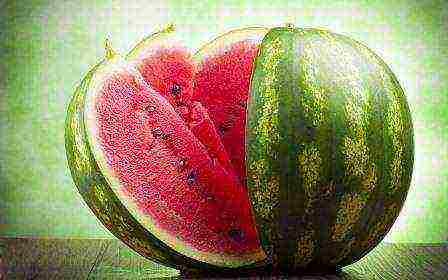 Thanks to modern technologies, growing berries and vegetables is no longer a fantasy. To understand how to grow a watermelon at home, you need to familiarize yourself in advance with some of the nuances that will allow you to collect an ecological and tasty harvest over time.
Thanks to modern technologies, growing berries and vegetables is no longer a fantasy. To understand how to grow a watermelon at home, you need to familiarize yourself in advance with some of the nuances that will allow you to collect an ecological and tasty harvest over time.
How to choose and plant seeds
First of all, you need to choose a material for planting.Not every variety of watermelon can be grown at home.The seeds of the delicious watermelon from the market or store are not suitable for this purpose, because this variety is grown in open areas in spring and summer.For the same reasons, varieties that are grown in summer cottages will not yet be suitable.

But there are hybrids that are resistant to lack of light, early maturing, they do not require special care. The following varieties are considered excellent: Ogonyok, Kaho, Sibiryak, Volgar, Gift of the Sun. They sprout very well, are tenacious, the fruits have a sweet taste.
After the acquisition, the planting material must be selected before growing the watermelon at home. Small and damaged seeds are eliminated immediately. Large seeds are dipped into a glass container containing a solution of sodium chloride. It is done like this: 5 g of salt per 0.1 l of water. Seeds that have sunk to the bottom must be removed, rinsed in water, and dried. It is these seeds that are needed for planting.

Then they are soaked in a solution of humate (0.5 g per 1 liter of water). This is done as follows: gauze is moistened, in which the seeds are left for a day. This will increase germination and reduce stress. You can also leave the seeds in a gauze moistened with plain water until they begin to hatch.
Then the seeds need to be planted in small plastic cups of 4-5 seeds each, the earth should be a little tamped in them.
Watering should be done in such a way that the soil is always moist. For seedlings to appear, the temperature must be about 25 ° C. Then the seedlings will appear after 1 week. If the temperature is below 13 ° C, then seedlings can not be expected.
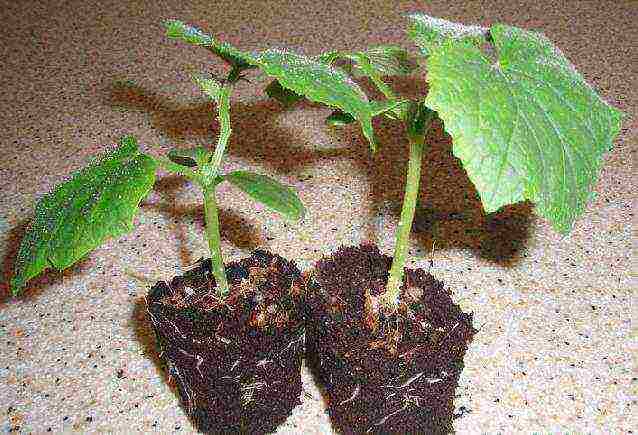
Cups should be in a well-lit and warm place. No need to allow drafts. After 2-3 weeks, 1 seedling should be left in each glass.
Watermelon care
As soon as 3 leaves appear, the plants are moved into containers, the volume of which is from 5 to 15 liters. They should contain a mixture of seedling soil and perlite in a 2: 1 ratio. It is necessary to water the plant often, but not abundantly, so that the water does not stagnate. The soil must be fertilized every 2 weeks. Liquid vegetable fertilizers work well here. You need to add 1 tsp in 1 liter of water. fertilizers. This solution can only be used for 1 watering.
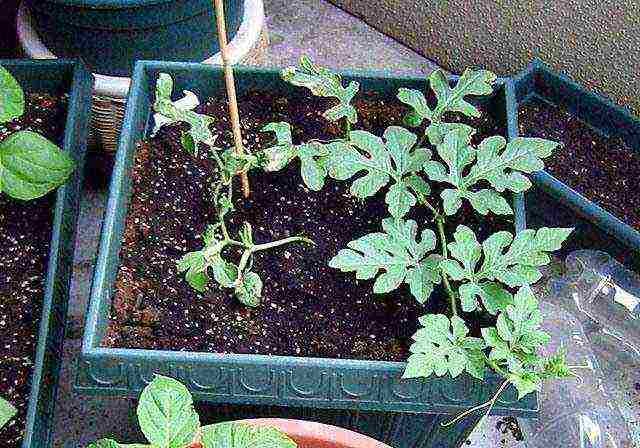
When 6 leaves grow, the plant is pinched over 4 leaves. The plant needs enough light. If there is not enough lighting, then additional LED or energy-saving lamps will be required.
Pollination of the plant and the appearance of fruits
In most cases, watermelons begin to bloom 30-50 days after germination.
To obtain an ovary, flowers require pollination.
To do this, you first need to find male flowers that have a thin stalk. Such flowers will need to be carefully picked, they need to pollinate the female flowers by touching the pistils with the stamens.
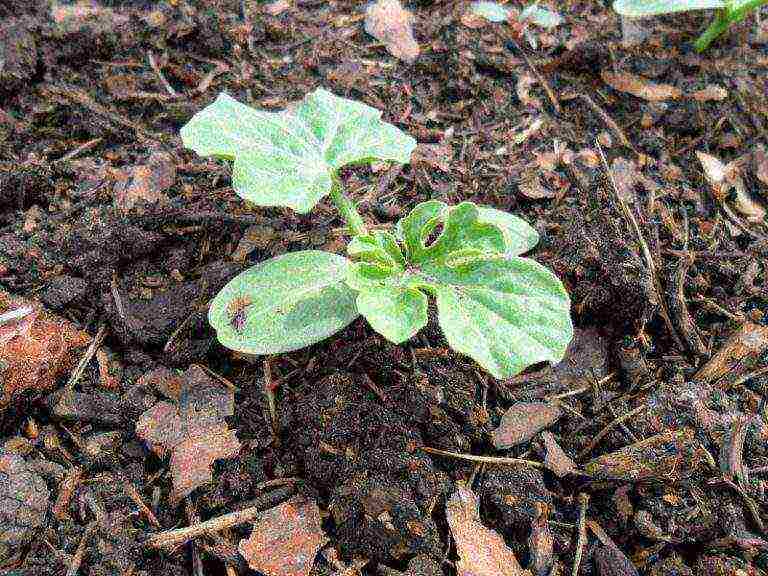
After a certain period of time, there will be noticeable wilting of the petals and an increase in the stalk, which over time will become a fruit. As the lashes grow, they will need to be pinched to stop their growth.
A few weeks before the fruit is fully ripe, watering should be minimized, stimulating the appearance of sugar in the berry. When the grown fruits are ripe, you can harvest.
How to grow watermelons in the country (video)
About the beneficial properties of watermelon
This berry contains a lot of sugar (about 12%). It is easily absorbed by the body and, unlike refined sugar, is beneficial.
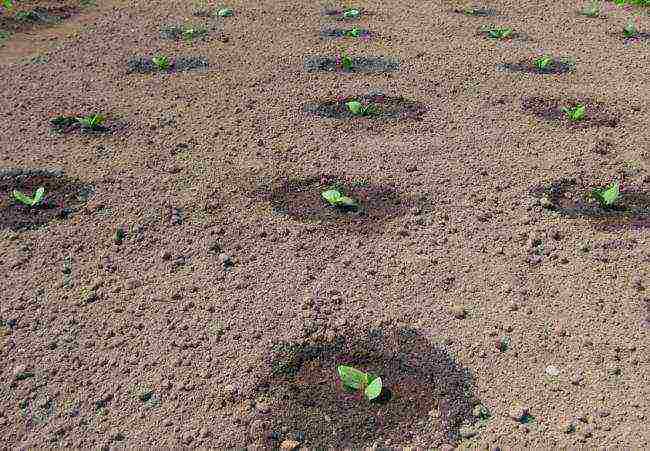
Watermelon juice has a diuretic effect, so it is able to flush the kidneys and ureters well. Thanks to him, salts are dissolved and washed out of the body. Watermelon juice is considered beneficial for people with kidney disease. Watermelon juice is also useful for people who have diabetes mellitus, cystitis, atherosclerosis.
Now you know about growing watermelon at home. We wish you a good harvest!
We plant watermelon seedlings in open ground (video)
Gallery: watermelon at home (15 photos)
Rate the article:
(3 votes, average: 3.3 out of 5)
It has become common for gardeners to grow watermelon.The process is simple, but it has certain difficulties that must be taken into account when growing (the plant may die even before flowering, the fruits do not always grow tasty, and so on). More details on how to grow a watermelon with your own hands will be discussed in this article.
How to grow a watermelon
Variety selection
The choice of a variety should be approached with special responsibility. For the middle zone of the Russian Federation, it is advisable to choose only early-ripening varieties, and there is no need to chase after huge fruits in this matter - such watermelons realize their potential by 100% only when grown in the south of the country. Be sure to read the description of the variety on the package - it contains information about the duration of ripening (the ovaries of plants should ripen as quickly as possible).
Choosing a watermelon variety
On a note! Some qualities can be neglected when choosing a variety. First of all, it is large-fruited and transportable. Also, do not pay attention to the color and shape of the fruit - this is necessary only in those cases when you grow watermelons not for yourself, but for sale.
The most common varieties of watermelon:
- "Kai";
- "Sugar baby";
- "Ataman F1";
- "Ultra early";
- Stokes;
- "Ogonyok";
- Charleston F1 near Moscow;
- "Yarilo";
- Krimstar F1;
- "Leader";
- "Pink Champagne F1";
- "Gift to the F1 North".
This is just a small part of the varieties that can be grown not only in the south of the country, but most often people choose them. Having decided on the type of watermelon, you can start growing.
There are many different varieties of watermelon
How to grow a watermelon outdoors
Not everyone knows, but watermelons can be grown without seedlings, but with seeds, already in a permanent place. Often, seedlings are used only for further transplantation into greenhouses, so that the watermelon ripens. But if you are growing a watermelon in a garden plot, then you can safely skip the stage with seedlings and sow seeds.
Growing seedlings of watermelons
The planting process is divided into several preparatory stages to obtain a good harvest. Let's consider each of them separately.
Seed preparation
Having chosen a suitable variety, wrap the seeds in a cloth bandage and place them on a shallow plate, filling them with a pre-prepared solution of potassium permanganate. The solution should be light pink and warm. After that, put the saucer with the seeds in a plastic bag and tie it up, taking in a little air. Transfer the seed plate to a warm room (at least + 20 ° C). Change the solution daily and ventilate the bag. After 2-3 days, the seeds should hatch, after which they will be ready for planting in the ground.
Watermelon seeds
Soil preparation
It is very important to prepare a plot of land before planting a watermelon. This is an integral part of growing, without which you are unlikely to get a good harvest. The prepared soil should provide the plants with nutrients throughout the entire growth period, it should be protected from strong winds, and also well lit.
Preparing the soil for planting
Clearing and leveling
For a watermelon, as well as for other melons and gourds, you need a loose, fertile and light soil. It's great if your suburban area has sandy loam or sandy soil, which you enriched with rotted humus in the autumn. If we talk about suitable predecessors of watermelons, then these are certainly tomatoes, potatoes, cruciferous vegetables, as well as legumes.
For the best result, it is advisable to prepare the beds in advance and fertilize the soil. To do this, 1 sq. m of the site, you need to add 20 g of potash fertilizers, 40 g of superphosphate and 30 g of ammonium sulfate. This combination of mineral fertilizers will significantly accelerate the growth of the watermelon, as a result of which you can enjoy juicy and sweet fruits a little earlier.
Fertilization
Sowing watermelon seeds
The process of planting watermelon seeds is simple and practically does not differ from planting any other crop.
Table. Step by step instructions for sowing watermelon seeds.
|
Step one |
Start sowing watermelon seeds in early May as it is a very thermophilic plant. Otherwise, if you do this earlier, the plant will greatly slow down in development. Take out the previously prepared seed material that has already germinated. |
|
Step two |
Also, you should have a planting mixture at the ready, consisting of rotted humus, ash, mineral fertilizers and peat (the composition may vary, since there are many different recipes for preparing the mixture). |
|
Step three |
Dig a large watermelon hole and fill it with a little water. |
|
Step four |
Pour the prepared fertilizer and humus mixture into the hole. Level gently with a hoe and water. |
|
Step five |
Place at least 5 seeds in the hole (5 cm deep) and sprinkle it all over with earth. The soil layer should be approximately 4 cm thick. Gently tamp the soil so that the seeds are not blown away or injured. Repeat the procedure for each well. |
Hole for watermelons in the open field
Important! First, you need to sow 5-6 seeds in each hole, but over time, when they begin to develop, leave one plant in the hole.
Follow-up care
Without providing full care, including feeding and watering, it is impossible to grow a watermelon in the garden. The juiciness of the fruits directly depends on the level of humidity, but you should not overdo it with this matter, because you cannot then feast on the sugar pulp of sweet berries, which everyone loves so much. Conditionally, follow-up care can be divided into 4 stages: watering, feeding, trimming lashes and destroying pests. Let's consider each of them separately.
Watering
When growing watermelons in a summer cottage, it is advisable to use drip irrigation systems. This will allow for regular feeding of crops.
The best option is drip irrigation.
For the most correct and accurate application of fertilizers, an agrochemical analysis of the soil is simply necessary.
Watermelons need abundant, but rare watering, especially in a hot season with a lack of natural moisture - remember this! For the comfortable growth of watermelons, the soil moisture level should be at least 80%. If the site is located on sandy soil, then the beds need to be watered more often due to poor moisture retention. Water clay soils and chernozem less often. After the berries begin to ripen and they become poured, reduce the number of watering, and after a few weeks, stop them altogether.
Top dressing
Top dressing of watermelons grown in a summer cottage consists of three procedures, each of which must be performed subject to certain conditions: at least 2 liters of liquid fertilizers must be per plant. After 7 days from the moment of planting the seeds, it is necessary to regularly water the plants with a special solution prepared with your own hands (all the ingredients and their proportions were described above).
Watermelons need to be fertilized in a timely manner
After the lashes on the plants begin to grow actively, you need to make a second feeding of the watermelons, but this time the amount of potash and phosphorus fertilizers should be half as much. When the formation of the ovaries begins, you need to carry out another top dressing, only with a different composition. Mix 10 liters of water, 35 g of potassium salts, 10 g of superphosphate and 20 g of ammonium sulfate.
Apply the prepared nutrient mixture to the prepared furrows, which should be 15 cm away from the plant bushes. The amount of nitrogen fertilizers should be reduced due to the likelihood of their accumulation in the pulp of watermelons. In addition, such measures can provoke the ripening of the plant, and not a set of green mass.
Fertilizer for watermelons, melons and pumpkins
Trimming the lashes
During a short and not warm enough summer, some fruits of the watermelon do not have time to ripen, although the bush still spends energy on them, which could be distributed to other berries that really ripen. Therefore, each plant should have no more than 5 watermelons. Delete all unnecessary items.
Watermelon formation scheme
Important! When growing watermelons, you need to remember that female flowers form on the main lash of the plant - you cannot touch them, but remove the side lashes. Compliance with all recommendations will allow you to get a harvest in the second half of August.
Pollination of watermelon flowers
Pest control
The melon aphid that appears in June can create many problems for watermelons. Living on the underside of the leaves, it sucks out all the life's juices from the plant, as a result of which the leaves wrinkle and dry. During the summer, aphids can give 2-3 generations. At first, the pests live only on weeds, but with the onset of June, females move to watermelons, staying there until the beginning of autumn. The melon aphid lays its eggs on the weeds, which hibernate there.
Melon or cotton aphid (Aphis gossypii)
To protect watermelons from aphids, it is advisable to regularly weed the beds from various weeds, as well as mow the areas located next to the grown watermelons. If you notice pests, immediately treat the plants with a special decoction or infusion made from celandine, garlic or onion husks. If these remedies do not help and the deciduous system of plants is severely damaged, then strong chemical preparations can be used - for example, "INTA-VIR", "Karbofos", "Iskra".
"Karbofos"
In addition to aphids, watermelons can be subject to various diseases, such as sclerotinia, bacteriosis, copperhead, various types of rot, and so on. For treatment, you need to prepare a decoction of horsetail. To do this, pour 1 liter of water with 1 tbsp. l. plants and cook over low heat for 15 minutes. Alternatively, you can use another remedy - milk mixed with iodine. If the plants have been heavily infested, use Cuprosat or Oxychloride. The development of fusarium wilting can lead to the fact that the plant will die in a few days. The spread of infection occurs through plant debris, seeds or soil.
We fight diseases in watermelons
As a prophylaxis of watermelon from the onset of diseases, it is advisable to treat the seeds with a solution of "Baktofit" for 3 hours before planting. If some plants were nevertheless damaged by an ailment, then they need to be destroyed in order to protect healthy ones from infection, which, in turn, need to be fed with potassium-phosphorus fertilizers.
"Baktofit"
Harvesting
Fruit picking is the final stage in the process of growing watermelons. It is not recommended to rush with this matter, because many fruits that have reached large sizes are still unripe. Ripe tomatoes can be identified by a change in the color of the fruit; when growing zucchini and cucumbers, it is important not to be late in picking, otherwise vegetables may lose their useful properties. But when should you harvest watermelons? When planting early ripening varieties, you can get a crop not earlier than mid-August. Mass harvesting during this period is not carried out, it is necessary to determine the ripeness of the berry by external signs. First of all, look at the bracts and antennae - if they are dry, then the watermelon can be harvested. Also, with a light tapping of your fingers on the berry, deaf sounds should be heard. The combination of these signs indicates the ripeness of the fruit.
Checking the ripeness of the watermelon
If you grow watermelons for further transportation and storage, it is better to pick the berries a couple of days before ripening. They will then mature in a warm and dry room. At the same time, watermelons will not lose their qualities.
Self-grown watermelons do not become boring!
Video - Growing watermelon seedlings
Among many summer residents and owners of personal plots, planting vegetables, fruits and berries for their own needs is quite an everyday activity.
Melons have been especially popular in recent years, but not everyone knows how to grow watermelons correctly, so that they are juicy, tasty, and the harvest pleases with abundance. There are many rules and recommendations regarding melons that should be followed in order to get a good harvest.
How to properly grow watermelons
The rules for growing berries are quite simple: you need to choose a suitable variety, prepare the soil, seeds or seedlings, plant and grow them according to the rules.
Let's consider each of the points in detail.
Choosing a variety of watermelons
Currently, more than 50 varieties of watermelons are grown in Russia, and their number is regularly increasing. All varieties are subdivided geographically into the following types:
- Transcaucasian;
- Western European;
- Russians;
- Central Asian;
- Indian.
The list is by no means complete, since there are a dozen more types of these berries. All watermelons grown in our country belong to the Russian variety. Sometimes Transcaucasian and Central Asian species are also grown.
Attention! When choosing a watermelon for planting, pay attention to its ripening period, to the resistance of watermelons to drought and frost, especially if you live in the middle lane.
Watermelons, which have a medium and late ripening period, are relevant for regions with a warm climate. Early varieties grow well in central Russia.
 How to properly grow watermelons
How to properly grow watermelons
The most popular varieties of watermelons in our country include the following varieties.
- Watermelon "Spark" - an early ripening variety that feels great in the non-black earth. Ripening period from 70 to 90 days. Fruits are small in size, round in shape with a thin skin, dark green in color. The weight of the berries is about 3 kilograms. The fruits are juicy, tender, sweet, bright red.
Seeds are planted from late April to early May. The ideal time for planting seedlings is from late May to early June. - Watermelon "Crimson Smith" - ideal for regions with short, sultry summers. Ripening time is approximately 60-70 days. Small watermelon, weighing up to 3 kilograms. The pulp is tasty, juicy, deep red.
The variety is resistant to various diseases. In particular, anthracnose and powdery mildew. - Watermelon "Producer" - a relatively new variety, suitable for regions with a warm climate. Has a first-class taste. Able to be stored for a long time, resistant to transportation over long distances.
All varieties of watermelons belonging to the Russian varieties are grown in almost all regions of our country. When choosing a watermelon for growing, pay attention to the recommendations for each specific variety, adhere to all the rules and recommendations for growing them.
Preparing the soil for growing watermelons
Before planting seeds or seedlings, we prepare the soil in advance. It is recommended to do this in the fall, using mineral and organic fertilizers. Scatter them evenly over the area of the intended sowing of berries, then carefully dig up the soil.
We loosen the soil in the spring, to the sowing depth, pour 1 tbsp into each hole. spoon of ammophoska or nitrophoska, thoroughly mixing the fertilizer with the ground.
To minimize the acidity of the soil and improve the growth of watermelons, we use magnesium, calcium, potassium. These elements are found in eggshells and wood ash. It is recommended to prepare them in advance.
Preparing watermelon seeds
Watermelons can be planted as seeds or seedlings. In any case, it is necessary to stratify the seeds in order to select the highest quality material for planting.
- To identify the strongest seeds, dip them in salt water. Those watermelon seeds that have risen to the surface are safely thrown away, and those that have sunk to the bottom are used for planting.
- To disinfect the seeds, before sowing, we leave them in the sun for a week or warm them up at a temperature of +55 degrees for 3-4 hours.
- To strengthen future sprouts and accelerate the germination process, we soak the seeds for a day in warm water and only then plant them in the ground.
 Preparation and planting of watermelon seeds
Preparation and planting of watermelon seeds
Sowing watermelon seeds
When planting watermelon seeds, be sure to take into account the peculiarities of the climatic zone. The soil temperature at a depth of 10 centimeters should be + 12- + 14 ° С.
- In the western and northern regions of the country, seeds are planted from May 15.
- In the southern part of the forest-steppe from May 6.
- In the steppe regions from April 28.
Previously, you should not plant watermelon seeds, as they will simply rot in cool soil. Before planting, we must warm up the ground.
We put no more than 5 watermelon seeds in the hole and sprinkle them with earth. The distance between the holes is not less than 0.7 -1.0 meters, and between the rows is about 1.5 meters. It is recommended to cover the sowing before emergence with a film or agrofibre.
When weeds appear, weed them immediately.
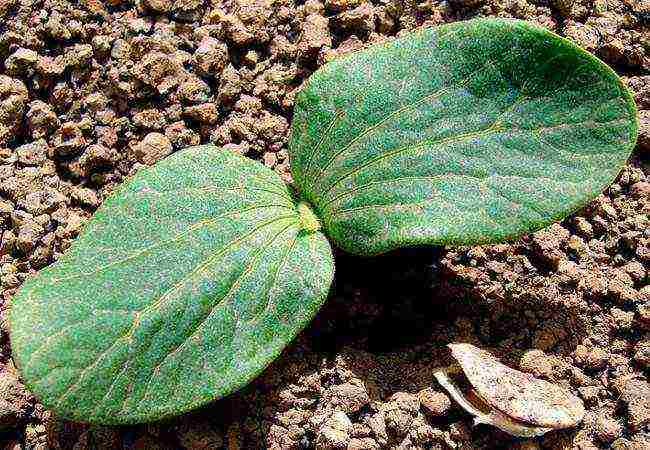 Watermelon sprout
Watermelon sprout
When tying leaves on seedlings, one strongest plant is left in each hole.
Planting watermelon seedlings
Wanting to get an early harvest or living in the northern regions, we plant not seeds, but seedlings of watermelons. We use pots or cut plastic bottles to grow it.
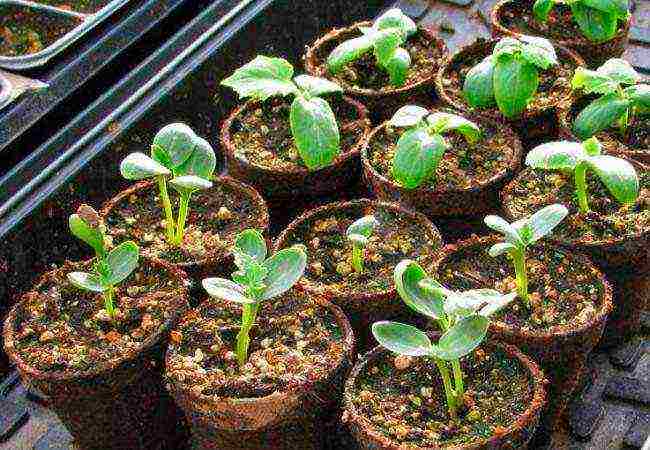 Seedlings of watermelon in peat pots
Seedlings of watermelon in peat pots
Seedling soil is a mixture of humus, turf soil and river sand. It is recommended to add some wood ash to the mixture.
Having planted the seeds, we leave them for 10 days in a dark place with a temperature of at least + 25 ° C. After this time, we rearrange the seedling pots for 20 days in a place with good lighting.
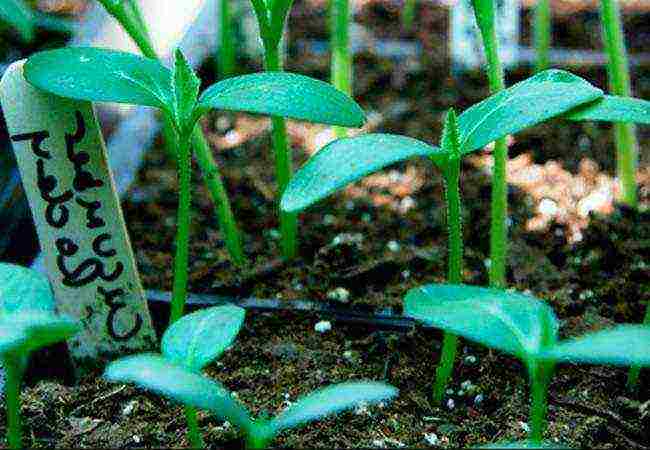 Planting watermelon seedlings
Planting watermelon seedlings
The last stage is hardening. It takes 5 days and implies a daily decrease in the temperature for seedlings by several hours. If the watermelon variety is resistant to cold, hardening is not necessary. Plant the seedlings in open soil after the frost is over.
Choosing a place for growing watermelons
One of the most important factors in obtaining a bountiful harvest of watermelons is the correct choice of the place for planting seeds or seedlings. The site must be protected from the wind and located in the sun.
Tomatoes, potatoes, beans, radishes, or cabbage are good precursors for watermelons.
The soil for watermelons is fertile, loose and light. We fertilize the sandy loam or sandy soil in advance with rotted organic matter or humus.
In pre-moistened wells, we plant no more than 2 plants. Their leaves must remain above the ground. The distance between the holes is from 1.0 to 1.5 meters. Cover the seedlings with foil and water them with warm water for a week.
 Choosing a place for growing watermelons
Choosing a place for growing watermelons
Watering and feeding watermelons
Good watering and timely feeding of watermelons is the key to a good harvest. Water is responsible for the juiciness of the fruit, but remember that it should be in moderation. Watering the seedlings abundantly and often, it is difficult to achieve the desired taste of the fruit.
Watering
Stick to the following scheme for watering the berries:
- Before the flowering of watermelons, we water them moderately, and then more abundantly.
- In extreme heat, we water the watermelons infrequently, but abundantly. Soil moisture - at least 85%.
- With sandy soil that does not retain moisture well, the plant is watered more often than with clay or black earth.
- When the fruits ripen, we reduce the number of watering, and gradually stop altogether.
Drip irrigation has proven itself well for this purpose.
Top dressing
Plant feeding is carried out in 3 stages. Each requires about 2 liters of liquid fertilizer.
- The first feeding of seedlings is carried out a week after planting. Add ammonium sulfate, superphosphate, and potassium salt to a 10 liter container of water.
- The second feeding is carried out during the active growth of watermelons.The solution is used the same as in the first procedure, but the amount of fertilizer is reduced.
- The last feeding procedure is carried out at the time of the formation of the ovaries. The solution is poured into previously prepared furrows, at a distance of 15-20 centimeters from the plants.
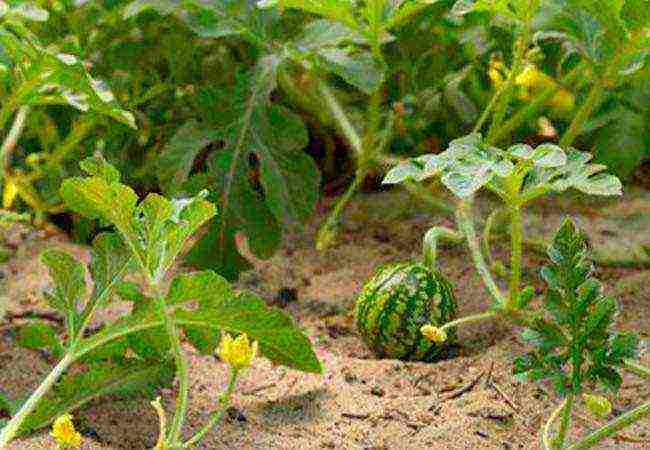 Watering and feeding watermelons
Watering and feeding watermelons
Watermelon Care and Harvesting
Care for watermelon seedlings includes the following procedures:
- Loosening the soil;
- Top dressing and watering;
- Disease and pest control;
- Weed removal;
- Frost protection for ovaries.
It is necessary to loosen the soil after planting seedlings, after rains and watering to a depth of 7 centimeters. With frequent winds, sprinkle the stems with soil or fix them with wire pins.
Growing watermelons by the melon method, after 3-6 ties we attach the shoots. If there is a chance of frost, we protect the plants with a special covering material or cardboard.
The watermelon harvest season starts at the end of August. Finding out that the fruit is ripe is quite simple: the tail will dry out, and the skin will become shiny. The drawing on the berry will take on distinct outlines. It is recommended to lightly tap the fruit. If the sound is dull, feel free to cut the berries.
As you can see, growing a watermelon is quite simple, the procedure does not require much time and effort. Following all the recommendations and advice, the harvest of watermelons will delight you with abundance, and the taste of the fruit will be at its best.


